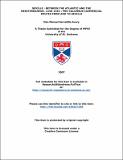Seville : between the Atlantic and the Mediterranean, 1248-1492 : pre-Columbus commercial routes from and to Seville
Abstract
The city of Seville and its port have had a prominent place in the history of early modern Europe and America. This city was not only the Gate of the Indies, but also the Gate of Europe for all the exotic goods and people that arrived in Europe via Seville's port. How this city achieved such a prominent place has traditionally been overshadowed by its post-1492 fame. This thesis demonstrates how, during the two hundred or so years before Columbus, different groups were able to shape this city into a commercial port that had made it the axis between the Mediterranean's commercial routes and those of the Atlantic Ocean. Beginning in 1248, with the Christian re-conquest, the monarchs set out to create an independent and powerful municipality, as well as a merchant class with distinctive city quarters and privileges. In turn, this merchant class affected the policies of both monarchy and city-council. Eventually, the policies of both merchants and the city-council led to the creation of an important exchange port that lay nearly between the two bodies of water. The Castilian monarchs, aware of this, also began the construction of the first Royal Ware houses and Dockyards, as well as determining the location of the Castilian Armada. It was those years between 1248 and 1492 that witnessed the birth of one of the most important naval ports of European history.
Type
Thesis, MPhil Master of Philosophy
Rights
Creative Commons Attribution-NoDerivs 3.0 Unported
http://creativecommons.org/licenses/by-nd/3.0/
Collections
Description of related resources
Archivo Municipal de Sevilla. Sección I.Archivo Municipal de Sevilla. Sección X.
Except where otherwise noted within the work, this item's licence for re-use is described as Creative Commons Attribution-NoDerivs 3.0 Unported
Items in the St Andrews Research Repository are protected by copyright, with all rights reserved, unless otherwise indicated.


